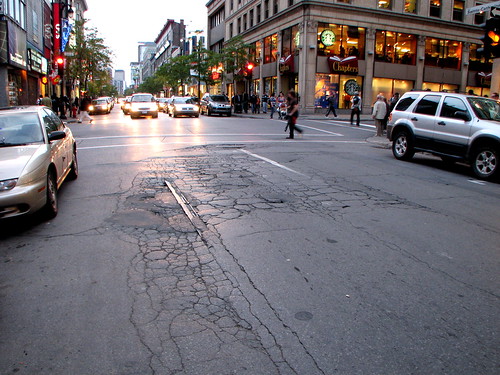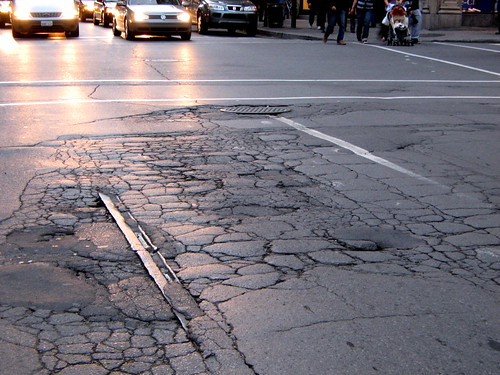When walking or biking around town, I would regularly notice these tracks that periodically appear due to pavement degradation. This previous photo was taken on Ste-Catherine (near Stanley), where one of the major streetcar arteries in Montreal used to pass through. There are occasionally discussions about reviving Montreal’s streetcar network, done for in 1956 for most of the downtown areas, but nothing new has emerged recently. Except perhaps nostalgia.
Remants of the Ste-Catherine streetcar tracks
By Cédric Sam
Read more articles by Cédric Sam



16 comments
Very unwise car-centric postwar decision. And yes, little as I like conspiracy theories, there really was a plot. It is sad to see their remnants now.
About time this disaster was reversed. I’d make a tram along avenue du Parc a priority, as the bus line is absolutely saturated, the Parc-Pine interchange obstacle has been destroyed and a swift tram line would take a lot of pressure off the orange métro line – extremely crowded since the extension to Laval.
I’d be interested in modern tram technology in snowy northern cities – although Amsterdam and Copenhagen are both far to the north of Montréal, Amsterdam gets practically no snow any more and Copenhagen very little. Perhaps some Swedish cities have snow and trams? Guess an integrated snowplough at the front would be needed.
The modern trams I am familiar with in European cities are comfortable, swift and accessible for people with reduced mobility (people using wheelchairs, seniors and others who have a hard time climbing steps) and parents with small children in strollers. In Amsterdam there are both sound and visual announcements of the next stop.
I think getting the tram running along Ste catherine street again would be a fantastic alternative to using the metro green line that is/can be a nightmare at rush hours. I wonder how extensive the old track network is? Any thoughts as to whether they can be re-instated?
Maria, the streetcars worked just fine in Toronto this past winter, which had a number of heavy snowfalls. The only problems I recall were due cars parked next to snowbanks that had yet to be cleared, which were too close to the streetcar’s tracks for them to get by without scraping.
If I recall there is a map of the old tram network somewhere here on this site. If not, elsewhere.
Though obviously the Ste-Catherine line would have to be rebuilt – and updated. Other than Amsterdam and the few new Paris trams, I remember wonderful trams in Strasbourg.
I think the Green line is probably so congested that having people using the trams for shorter distances would be a boon to all. I live near Jean-Talon market, so obviously I use the orange line more (sometimes the blue line, but as I’m no longer attending Université de Montréal, I usually find buses more practical for short runs east or west if I can’t walk or ride my bicycle.)
I saw some old cobblestones peeking through the crumbling ashphalt in the Griff today. This photo of the tracks is similar in that the old road is trying to escape the new. In both cases, I think I prefer the old, and wish them the best of luck in re-establishing themselves.
In both Boston and San Francisco where I lived for a while, there are similar scenes of paved-over tracks, though they never got rid of all of them, unlike other cities (LA) but it’s a tell-tale oddity that the numbering/letter systems in both cities have prominent gaps, for the lines that were discontinued. IN SF they brought back the Market St. F Line during the time I lived there.
Europe sure is a contrast – I still remember the Strassenbahn in Munich from my early childhood there, and although it’s been years since I was back there, it seems to still be an integral part of their transit system (“S-Bahn”, in green):
http://www.toytowngermany.com/xtra/images/munich-public-transport-2006.png
It would be a great benefit for the environment, as well as the overall tranquility of the neighbourhoods to have streetcars return. Living next to a bus route in Outremont is nerve racking!
When I was over in Helsinki Finland a few years ago, I was pleasantly surprised to see tramways all over the city. Helsinki is almost 60 degrees north, as well as having an extremely long and harsh winter. I don’t see any reason why we couldn’t have a system here again.
Let’s hope that in the Griff, the powers that be have enough sense to realize that the cobblestone should be restored.
Some of the old rails were ripped up about two years ago on Ste-Catherine near Atwater as can be seen here:
http://citynoise.org/article/4045
I’m glad to hear about the Helsinki trams!
There were famously trams in “Petrograd” as St-Petersburg-Petrograd-Leningrad-St-Petersburg was called when Mayakovsky wrote his revolutionary-era poems…
Yes, this past winter was unusually snowy in Toronto and even Hamilton! Glad to here that the streetcars there proved up to it.
Trams are wonderful, and so much more pleasant to ride than a bus. But they can be noisy. In Amsterdam, the city subsidises double glazing for the window of residences along tram lines. All the more because they run so frequently!
Good riddance, metro need extension and capacity upgrade, why not a metro line running along Parc?
Tramways are frankly useless and too expensive for their own good.
Trams can only work well if they have their own right of way. The new Spadina tram line in Toronto is totally right of way. Cars and trams cannot mix on the street as they used to, and that is why they mostly disappeared from the streets of Montreal. The Millen, Cartiervile, and Lachine lines were exceptions, but the post war modernist mentality got rid of those, and now we have Henri-Bourassa blvd east, a former right of way, and the orange line running parallel a few blocks away from what is now Millen street, and of course the Decarie and #20 expressways both former tram right of ways.
Large boulevards such as Pie IX and Rene-Levesque can accomodate tram right of ways, and that is the way to go. In fact the former could even be extended into Laval.
The old Montreal trams had one problem in the winter and that was black rail. On very cold nights ice would form on the rails and would be dangerous so special salt brine cars had to work overnight to keep the system running. I think today it would not be a problem if salt were spread although it would deteriorate the tracks more quickly.
The Metro is the most imbicilic mass transit project ever conceived in Montreal. Rubber tired trains and snow cannot mix, so we are forever bound to build extremely expensive tunnels, which means the Metro will not expand very much over the years. In most cities, subways run on the surface (or even elevated) in less dense areas of population, a very cheap way of covering large areas.
The noise level of the all those tries on the Metro trains is beyond the danger level for hearing losswhen they speed out of a station, by the way.
Trams are actually cheaper to operate than diesel buses in high passenger volume areas even with the maintenace of trackage and catanery. That is because there is little to wear out apart from wheel bearings on the rolling stock. And of course, electricity can be cheaper than diesel fuel.
Trams are more efficient, stronger, and of course pollution free. Diesel fumes are carcinogenic by the way. Amazing that Quebec has so much electricity and how little of it is used for pollution free transportation.
Suspension technology in the past 30 years has reduced considerably the steel wheel on rail noise problem.
If you have researched why the metro is using rubber tires you would have spared us from your ignorant and useless remarks.
The tire rubber are there for a reason, the tunnels have steeper inclinations that cannot be climbed with steel wheels… so why are the tunnels so steep?? why don’t you research it? ;)
As for not using electricity? hello? the metro and some commuter lines are electric and move more people than other forms of transport in Montreal.
oh and rubber tires do not prevent the metro from running outside. Cars, bus and trucks all have rubber tires right?
The ventilation system is not weather proof, thats the only reason why there’s no outside lines… but i’m sure it’s not impossible to create weatherproof cabins.
A new tram line today would cost some where between $2-5 million per kilometre to build, but in the long they’re cheaper & cleaner to run than buses.
Malek:
Maybe you are the one that should do the research. The metro does not climb up Mount Royal, and even then, the trams that did had no problem with the grade. There are no grades too steep for steel on rail in the Metro, and if there were, that is usually worked around by lengthening the grade. The entire issue was political, a pet project of the Mayor Drapeau who wanted something unique for Montreal, of course, it was the taxpayers who paid for it, not him.
If you think rubber tired metros are not a problem in the winter, you had better think again with the problems Paris has following the rare snow storm.
Moreover, rubber tires wear out, needing replacement. Nice to pay for that nonsense when the money could be going for upgrading instead of unnecessary maintenance.